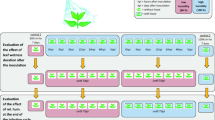Abstract
As a basis for a prognosis model for the protection of sweet cherries against the cherry leaf scorch, caused by Gnomonia erythrostoma, this research investigates the formation and propagation of the spores of the disease between 1998 and 2001. G. erythrostoma forms perithecia with ascospores as sexual fruiting bodies and pycnidia with conidia as asexual fruiting bodies. It was observed that the beginning of the spore ejection differed considerably between the years concerned; in 1998 the first ascospores, which were released from perithecia formed in leaves during the previous year, were detected at the end of April, in 1999 at the end of March and in 2000 at the middle of March. The duration of spore maturation depends on the temperatures between autumn and spring. The higher the temperatures the faster the maturation and the earlier the spore dispersal. The ejection of spores takes place in the spring, only under the condition that the dead and dried leaves from the year before are thoroughly wet. The perithecia-covered leaves remain on the tree throughout the winter until summer, which makes the disease very distinct. These conditions for ejection occur usually only after sufficient precipitation or after nights with extremely high humidity (≥ 90%). The end of the spore dispersal depends on the frequency of precipitation and the amount of the inoculum. Regular rainfall results in short spore dispersal, longer periods without precipitation lead to a longer spore propagation. Two conditions have to be met for the infection to occur: first, the leaves have to be developed completely or the fruit has to be visible; and second, the leaves have to be thoroughly wet for at least six hours for the spores to germinate and successfully infect the leaves or fruits. An infection with conidia can be excluded due to their lack of germination ability.
Zusammenfassung
Zur Entwicklung eines Prognosemodells zur Bekämpfung der von Gnomonia erythrostoma verursachten Blattbräune an Süßkirschen wurde die Sporenentwicklung und Ausschleuderung des Krankheitserregers in den Jahren 1998 bis 2001 verfolgt. G. erythrostoma bildet Perithecien als Hauptfruchtform mit Ascosporen und Pyknidien als Nebenfruchtform mit Konidien. Der Beginn des Ascosporenfluges war in den Jahren 1998 bis 2000 sehr unterschiedlich. Während im Jahr 1998 der Sporenflugbeginn sehr spät erfolgte (Mitte/Ende April), wurden die ersten Sporen im Jahr 1999 und 2000 bereits Mitte/Ende März gefangen. Die Dauer der Ascosporenreifung und damit der Beginn des Ascosporenfluges hängt wesentlich von den Temperaturen ab, die im Zeitraum Herbst bis Frühjahr herrschen. Je höher diese sind, desto schneller reifen die Ascosporen in Perithecien heran, die im Spätsommer/Frühherbst auf den befallenen Blättern angelegt sind. Die Sporenentlassung erfolgt im Frühjahr nur nach völliger Durchnässung der perithecientragenden Blätter des Vorjahres, die meist, für das Erscheinungsbild der Krankheit typisch, bis in den Sommer an den Bäumen verbleiben. Diese Bedingungen herrschen nur nach ausreichenden Niederschlägen oder nach Nächten mit extrem hoher relativer Luftfeuchte (≥ 90%). Das Ende des Sporenfluges hängt von der Niederschlagshäufigkeit und der Menge des Inokulums ab. Regelmäßige Niederschläge schläge führen zu einem kurzzeitigem Sporenflug, Trockenperioden verschieben das Ende des Ascosporenausstoßes. Damit es zu Infektionen kommt, müssen zwei Bedingungen erfüllt sein: erstens müssen die Blätter entfaltet bzw. die Frucht angelegt sein und zweitens benötigen die Sporen nach der Ausschleuderung für die Auskeimung und Infektion eine durchgehende Blattnässe von mindestens 6 Stunden. Eine Infektion durch Konidien ist wegen deren fehlender Keimfähigkeit auszuschließen.
Similar content being viewed by others
Literature
Feucht, W., T. VOGEL, H. SCHIMMELPFENG, D. TREUTTER, V. ZINKERNAGEL, 2001: Kirschen- und Zwetschenanbau. Eugen Ulmer Verlag, Stuttgart.
Frank, B., 1887: Die jetzt herrschende Krankheit der Süsskirschen im Altenlande. Landw. Jahrb. 16, 401–436.
Hasyn, S., 1996: Untersuchungen zur Blattbräune der Kirschen und deren Erreger Gnomonia erythrostoma. Diploma thesis, Technical University of Munich.
Royal Horticultural Society, 2005: www.rhs.org.uk/advice/profiles1100/cherry_scorch.asp.
Author information
Authors and Affiliations
Corresponding author
Rights and permissions
About this article
Cite this article
Hecht, D., Zinkernagel, V. Epidemiological studies of cherry leaf scorch (Gnomonia erythrostoma (Pers.) Auerswald). J Plant Dis Prot 113, 68–73 (2006). https://doi.org/10.1007/BF03356159
Received:
Accepted:
Published:
Issue Date:
DOI: https://doi.org/10.1007/BF03356159




